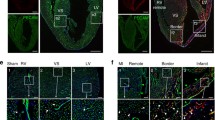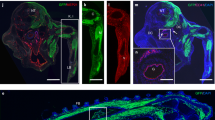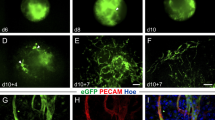Abstract
Angiogenesis is a hallmark of expanding tissue e.g. during embryogenesis and wound healing in physiology as well as in diseases such as cancer and atherosclerosis. Key steps of the angiogenic process involve growth factor-mediated stimulation of endothelial cell sprouting and tube formation. Heparan sulphate proteoglycans (HSPGs) have been implicated as important co-receptors of several pro-angiogenic proteins. The importance of HSPGs in physiology was underscored by the finding that knockout of the gene encoding HS polymerase, EXT-1, resulted in early embryonic lethality. Here, we describe the establishment of HS-deficient endothelial cells from sprouting aortas as well as from the lungs of EXT-1flox/flox mice. Recombination of the loxP-flanked EXT-1 locus by Cre-expressing adenovirus was demonstrated at the mRNA level. Moreover, depletion of HS polysaccharides was verified by flow cytometry and fluorescence microscopy methodology using phage display-derived anti-HS antibodies. In summary, we provide a genetic model to unravel the functional role of HSPGs specifically in primary endothelial cells during early steps of angiogenesis. Our studies are applicable to most loxP-based transgenic mouse strains, and may thus be of general importance in the angiogenesis field.



Similar content being viewed by others
References
Abramsson A.; Kurup S.; Busse M.; Yamada S.; Lindblom P.; Schallmeiner E.; Stenzel D.; Sauvaget D.; Ledin J.; Ringvall M.; Landegren U.; Kjellén L.; Bondjers G.; Li J. P.; Lindahl U.; Spillmann D.; Betsholtz C.; Gerhardt H. Defective N-sulfation of heparan sulphate proteoglycans limits PDGF-BB binding and pericyte recruitment in vascular development. Genes Dev 21: 316–331; 2007.
Armstrong L. C.; Björkblom B.; Hankenson K. D.; Siadak A. W.; Stiles C. E.; Bornstein P. Thrombospondin 2 inhibits microvascular endothelial cell proliferation by a caspase-independent mechanism. Mol Biol Cell 13: 1893–1905; 2002.
Belting M. Heparan sulfate proteoglycan as a plasma membrane carrier. Trends Biochem Sci 28: 145–51; 2003.
Bishop J. R.; Schuksz M.; Esko J. D. Heparan sulphate proteoglycans fine-tune mammalian physiology. Nature 446: 1030–1037; 2007.
Carmeliet P.; Jain R. K. Angiogenesis in cancer and other diseases. Nature 407: 249–257; 2000.
Dennissens M. A.; Jenniskens G. J.; Pieffers M.; Versteeg E. M.; Petitou M.; Veerkamp J. H.; van Kuppevelt T. H. Large, tissue-regulated domain diversity of heparan sulphates demonstrated by phage display antibodies. J Biol Chem 277: 10982–10986; 2002.
Esko J. D.; Selleck S. B. Order out of chaos: assembly of ligand binding sites in heparan sulphate. Annu Rev Biochem 71: 435–471; 2002.
Feyzi E.; Lustig F.; Fager G.; Spillmann D.; Lindahl U.; Salmivirta M. Characterization of heparin and heparan sulphate domains binding to the long splice variant of platelet-derived growth factor A chain. J Biol Chem 272: 5518–5524; 1997.
Folkman J. Angiogenesis in cancer, vascular, rheumatoid and other disease. Nat Med 1: 27–31; 1995.
Forsten-Williams K.; Chua C. C.; Nugent M. A. The kinetics of FGF-2 binding to heparan sulphate proteoglycans and MAP kinase signaling. J Theor Biol 233: 483–499; 2005.
Gitay-Goren H.; Soker S.; Vlodavsky I.; Neufeld G. The binding of vascular endothelial growth factor to its receptors is dependent on cell surface-associated heparin- like molecules. J Biol Chem 267: 6093–6098; 1992.
Inatani M.; Irie F.; Plump A. S.; Tessier-Lavigne M.; Yamaguchi Y. Mammalian brain morphogenesis and midline axon guidance require heparan sulphate. Science 302: 1044–1046; 2003.
Lin X.; Wei G.; Shi Z.; Dryer L.; Esko J. D.; Wells D. E.; Matzuk M. M. Disruption of gastrulation and heparan sulphate biosynthesis in EXT1-deficient mice. Dev Biol 224: 299–311; 2000.
Lindblom P.; Gerhardt H.; Liebner S.; Abramsson A.; Enge M.; Hellstrom M.; Backstrom G.; Fredriksson S.; Landegren U.; Nystrom H. C.; Bergstrom G.; Dejana E.; Ostman A.; Lindahl P.; Betsholtz C. Endothelial PDGF-B retention is required for proper investment of pericytes in the microvessel wall. Genes Dev 17: 1835–1840; 2003.
Lundin L.; Larsson H.; Kreuger J.; Kanda S.; Lindahl U.; Salmivirta M.; Claesson-Welsh L. Selectively desulphated heparin inhibits fibroblast growth factor-induced mitogenicity and angiogenesis. J Biol Chem 275: 24653–24660; 2000.
Marelli-Berg F. M.; Peek E.; Lidington E. A.; Stauss H. J.; Lechler R. I. Isolation of endothelial cells from murine tissue. J Immunol Methods 244: 205–215; 2000.
McCormick C.; Duncan G.; Goutsos K. T.; Tufaro F. The putative tumor suppressors EXT1 and EXT2 form a stable complex that accumulates in the Golgi apparatus and catalyzes the synthesis of heparan sulphate. Proc Natl Acad Sci USA 97: 668–673; 2000.
Rapraeger A. C.; Krufka A.; Olwin B. B. Requirement of heparan sulphate for bFGF-mediated fibroblast growth and myoblast differentiation. Science 252: 1705–1708; 1991.
Robinson C. J.; Mulloy B.; Gallagher J. T.; Stringer S. E. VEGF165-binding sites within heparan sulphate encompass two highly sulphated domains and can be liberated by K5 lyase. J Biol Chem 281: 1731–1740; 2006.
Ruhrberg C.; Gerhardt H.; Golding M.; Watson R.; Ioannidou S.; Fujisawa H.; Betsholtz C.; Shima D. T. Spatially restricted patterning cues provided by heparin-binding VEGF-A control blood vessel branching morphogenesis. Genes Dev 16: 2684–2698; 2002.
Spivak-Kroizman T.; Lemmon M. A.; Dikic I.; Ladbury J. E.; Pinchasi D.; Huang J.; Jaye M.; Crumley G.; Schlessinger J.; Lax I. Heparin-induced oligomerization of FGF molecules is responsible for FGF receptor dimerization, activation, and cell proliferation. Cell 79: 1015–1024; 1994.
Vlodavsky I.; Korner G.; Ishai-Michaeli R.; Bashkin P.; Bar-Shavit R.; Fuks Z. Extracellular matrix-resident growth factors and enzymes: possible involvement in tumor metastasis and angiogenesis. Cancer Metastasis Rev 9: 203–226; 1990.
Voyta J. C.; Via D. P.; Butterfield C. E.; Zetter B. R. Identification and isolation of endothelial cells based on their inCreased uptake of acetylated-low density lipoprotein. J Cell Biol 99: 2034–2040; 1984.
Welch J. E.; Bengtson P.; Svensson K.; Wittrup A.; Jenniskens G. J.; Ten Dam G. B.; Van Kuppevelt T. H.; Belting M. Single chain fragment anti-heparan sulphate antibody targets the polyamine transport system and attenuates polyamine-dependent cell proliferation. Int J Oncol 32: 749–756; 2008.
Wittrup A.; Zhang S. H.; ten Dam G. B.; van Kuppevelt T. H.; Bengtson P.; Johansson M.; Welch J.; Mörgelin M.; Belting M. ScFv antibody-induced translocation of cell-surface heparan sulfate proteoglycan to endocytic vesicles: evidence for heparan sulfate epitope specificity and role of both syndecan and glypican. J Biol Chem 284: 32959–67; 2009.
Yayon A.; Klagsbrun M.; Esko J. D.; Leder P.; Ornitz D. M. Cell surface, heparin-like molecules are required for binding of basic fibroblast growth factor to its high affinity receptor. Cell 64: 841–848; 1991.
Acknowledgements
The Swedish Cancer Fund; The Swedish Research Council; The Crafoordska Foundation; The Gunnar Nilsson Cancer Foundation; The Swedish Society of Medicine, and the Lund University Hospital/Region Skåne (ALF).
Author information
Authors and Affiliations
Corresponding author
Additional information
Editor: J. Denry Sato
Rights and permissions
About this article
Cite this article
Kucharzewska, P., Welch, J.E., Birgersson, J. et al. Establishment of heparan sulphate deficient primary endothelial cells from EXT-1flox/flox mouse lungs and sprouting aortas. In Vitro Cell.Dev.Biol.-Animal 46, 577–584 (2010). https://doi.org/10.1007/s11626-010-9313-3
Received:
Accepted:
Published:
Issue Date:
DOI: https://doi.org/10.1007/s11626-010-9313-3




